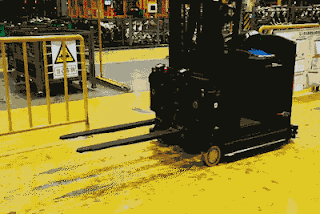With the growth of AI technology, unmanned warehouses gradually become possible.
Some experts believe automatic warehouse is one of the key measurements to enhance
producer service experience. However, pressures from rising wages and push from
emerging industries are leading manufacturers to reconsider the investment plan
for unmanned warehouse and automated facilities.
Unmanned warehouse is
too much to afford with rising manufacturing cost
There are mainly two ways to have a fully automated warehouse: build brand-new
intelligent warehouses to replace existing facilities, or convert existing
facilities in the warehouse make it automatic.
For giant companies in manufacturing industry, building large new automatic
warehouses is an effective move against profit squeeze. But it is another story
for small and medium enterprises. Challenges are not only to buy automatic
facilities such as AGV robots and AS/RS systems, or the expensive technical
service followed, but also to sacrifice a great part of productivity during
equipment installation. Such “makeover” is a real headache.
 |
| Photo: JD.com's “Asia No.1” Warehouse in Shanghai |
Forklift AGV becomes an urgent demand to impel intelligent manufacture
It seems that converting existing facilities to automatize traditional
warehouse is the only option to go. And this is exactly what VisionNav Robotics
can provide.
"Forklift is one of the primary loader
equipment mostly used in warehouses and factories. When we upgrade traditional
forklifts into forklift AGVs, we are also helping our customer to maximize
their current assets and to save their labor costs.” said Dr. Li Luyang, co-founder
and CEO of VisionNav Robotics.
But how to upgrade? VisionNav Robotics uses indirect external or pure
external methods to upgrade forklifts. With combination to company processes,
integration to superior software and collaboration with other automatic
equipment, forklift unmanned upgrade is quick and easy.
Unmanned forklift technology mainly includes
three elements:
1) Navigation technology: there are electro-magnetic,
laser, inertial, GPS, two-dimensional code, vision, and other types in the
market. Although laser + inertial and vision (camera) are both commonly used
for forklift AGVs, vision navigation is the more suitable in various working
conditions in terms of cost and position accuracy,
 |
| Figure: VisionNav Robotics reveals vision positioning technology under high-speed |
2) Perception: the identification of pallets and cages,
precise picking with self-adaptive fork, rack beam detection, cargo stacking and
spatial detection all rely on perception technique. "We’ve spent around
1 year to optimize spatial perception
capabilities of driverless forklifts, which becomes a great breakthrough in many
of our projects." Fang Mu, CTO of VisionNav Robotics, believes spatial perception technology is the
key factor to the success of unmanned forklifts applications.
 |
| VisionNav Robotics forklift AGV: pallet detection and fork arm self-adaptation |
 |
VisionNav Robotics forklift AGV: storage location detection
|
 |
| VisionNav Robotics forklift AGV: in-place detection |
3) Safety: To replacing human by robots, safety is the
first priority. Safety protection normally includes contact and non-contact protection.
Non-contact protection is to use sensors to scan obstacles in external environment
for safety avoidance. Laser obstacle avoidance is the most widely used because
it’s the most mature and safe. It is also superior to infrared and ultrasonic in
terms of accuracy, feedback speed, anti-interference ability and effective range.
Contact protection is more for vehicle body protection. The most common
approach is to install bumpers all around the vehicle body.
VisionNav Robotics unmanned solution application
VisionNav Robotics is committed to create a universal platform
for industrial driverless vehicles. Start with forklift AGV, VisionNav Robotics
can break through communication barriers for intelligent manufacturing, and improve
producer service experience as soon as possible.
At present, VisionNav Robotics unmanned project has launched in many famous
world-class companies. They helped more than 150 companies in the past two years
with unmanned upgrade solutions. Industries cover e-commerce logistics, automotive
new energy, FMCG, manufacturing, bonded, 3rd parties logistics and so on.





No comments:
Post a Comment